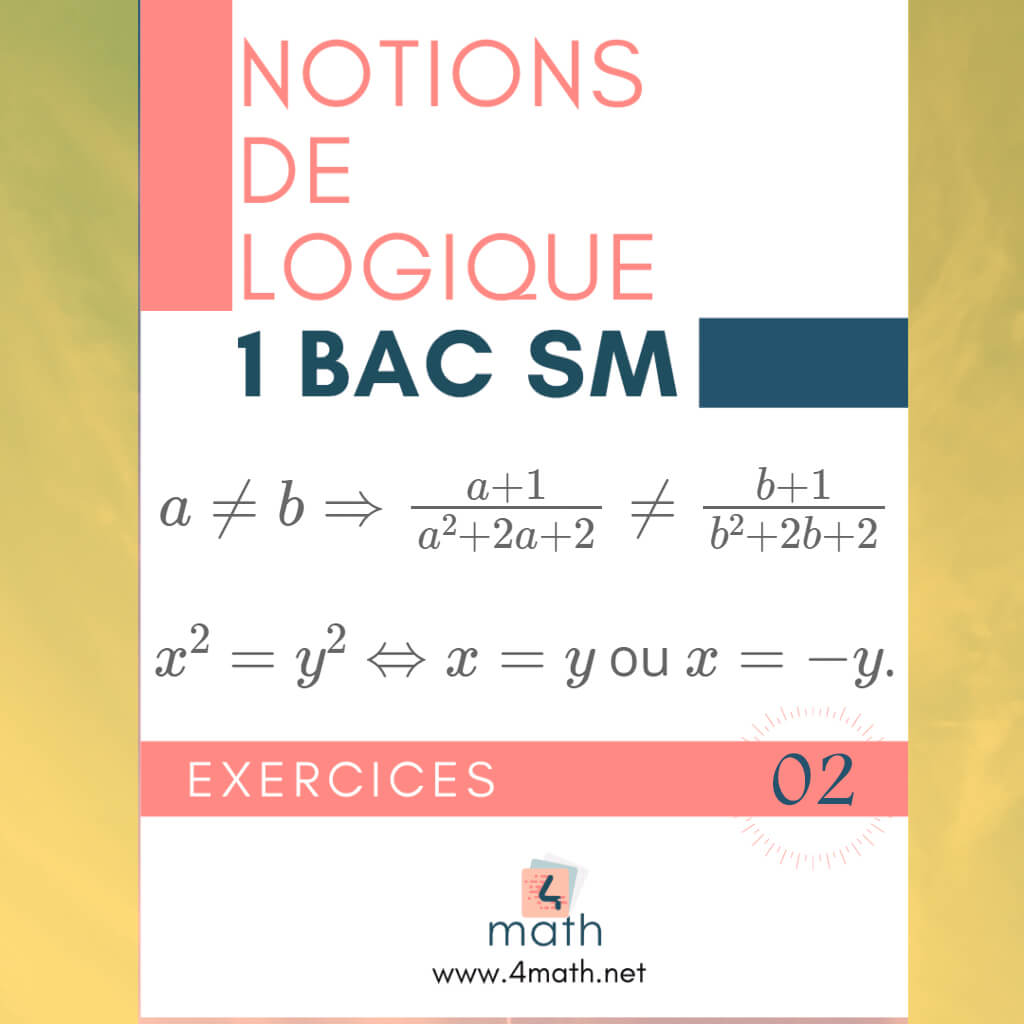
Opération sur les Propositions (logique)
Exercice1
Soient \(p, q\) et \(r\) trois propositions; on considère la proposition \(A:(p\) et \(q) \Rightarrow r\)
1) Donner la négation de la proposition \(A\).
2) Déterminer la valeur de vérité de \(A\) dans chacun des cas suivants:
\(a-p\) est fausse
\(\mathrm{b}-r\) est vraie
Exercice 2
Soient \(p\) et \(q\) deux propositions
On considère la proposition, \(A:(p \Rightarrow q) \Rightarrow \bar{q}\)
1) Donner la négation de la proposition \(\mathrm{A}\)
2) Déterminer la valeur de vérité de la proposition \(A\) dans chacun des cas suivants:
a- \(q\) est vraie
b- \(q\) est fausse
Exercice3
Soient \(p, q\) et \(r\) trois positions.
Montrer que:
1) \(A:[p \Rightarrow(q \Rightarrow r)] \Leftrightarrow[(p\) et \(q) \Rightarrow r]\)
2) \(B:[p \Rightarrow(q\) et \(r)] \Leftrightarrow[(p \Rightarrow q)\) et \((p \Rightarrow r)]\)
Quantificateur (logique)
Exercice 4
On considère les propositions \(P, Q\) et \(R\) telles que:
\(P:\left(\forall x \in \mathbb{R}^{+}\right) ; \frac{x+1}{2} \geq \sqrt{x}\)
\(Q:(\forall x \in] 0,[)1 ;(\forall y \in] 0,[)1, \frac{1}{x}+\frac{1}{y}>2\)
\(R:\left(\exists x \in \mathbb{R}^{+}\right) ; \frac{1}{1+\sqrt{x}}=1\)
1) Donner la négation de chacune des propositions \(P, Q\) et \(R\).
2) Montrer que chacune des propositions \(P, Q\) et \(R\) est vraie.
Exercice 5
On considère les propositions suivantes:
\(P:\left(\forall x \in \mathbb{R}^{+}\right), \frac{1}{1+\sqrt{x}} \neq 1\)
\(Q:(\exists x \in] 0,[)1, \frac{2 x}{1+x^{2}}>1\)
\(R:(\forall x \in \mathbb{R}),(\exists y \in \mathbb{R}), \frac{2 y}{1+y^{2}}>x\)
1) Donner la négation de chacune des propositions \(P, Q\) et \(R\).
2) Montrer que chacune des propositions \(P, Q\) et \(R\) est fausse.
Exercice 6
On considère les propositions \(A, B\) et \(C\) telles que:
\(A:(\forall x \in \mathbb{R}),\left(x^{2} \in \mathbb{N}\right) \Rightarrow(x \in \mathbb{Z})\)
\(B:\left(\exists x \in \mathbb{R}^{+}\right),(x>1) \Rightarrow\left(x^{2}<1\right)\)
\(C:(\forall x \in \mathbb{R}),(x \leq 0) \Rightarrow\left(x^{2} \geq 2\right)\)
1) Donner la négation de chacune des propositions \(A, B\) et \(C\).
2) Montrer que chacune des propositions \(A, B\) et \(C\) est fausse.
Exercice 7
On considère les propositions \(A, B\) et \(C\) telles que:
\(A:(\forall x \in \mathbb{N}), \sqrt{x-1}+\left|x^{2}-1\right| \neq 0\)
\(B:(\forall x \in \mathbb{R}), x^{2} \in \mathbb{Z} \Rightarrow x \in \mathbb{Z}\)
\(C:(\forall x \in] 1,+\infty[), \frac{x}{\sqrt{x-1}}<2\)
1) Donner la négation des propositions \(A, B\) et \(C\).
2) Montrer que chacune des propositions \(A, B\) et \(C\) est fausse.
Logique et raisonnement mathématique
Exercice 8
Montrer que:
1) \(\forall(x, y) \in \mathbb{R}^{2},(x y-2=y-2 x) \Leftrightarrow(x=1\) ou \(y=-2)\).
2) \(\forall(a, b) \in \mathbb{R}^{2}, \frac{a^{2}+b^{2}}{2}=a+b-1 \Leftrightarrow(a=1\) et \(b=1)\)
3) \(\left(\forall x \in \mathbb{R}^{+}\right),(\sqrt{2 x+2}-\sqrt{x}=1) \Leftrightarrow(x=1)\).
Exercice 9
Soient \(x\) et \(y\) deux nombres réels.
Démontrer que: \(x^{2}=y^{2} \Leftrightarrow x=y\) ou \(x=-y\).
Exercice 10
Montrer que:
1) \(\left(\forall x \in \mathbb{R}^{+}\right),\left(\forall y \in \mathbb{R}^{+}\right), \frac{x+y+2}{2}=\sqrt{x}+\sqrt{y} \Leftrightarrow(x=1\) et \(y=1)\).
2) \(\forall(x, y) \in \mathbb{R}^{2}, x y+6=3 x+2 y \Leftrightarrow(x=2\) ou \(y=3)\)
3) (∀x∈[1,+∞[),(∀y∈[2,+∞[),
\(\sqrt{x-1}+2\sqrt{y-2}=\frac{x+y+2}{2}) ⇔(x=2\) et \(y=6)\)
Exercice 11
Montrer que:
\(\left(\forall a \in\left[0,+\infty[), a<\sqrt{3+\sqrt{3}}-2 \Rightarrow a^{4}+8 a^{3}+18 a^{2}+8 a<3\right.\right.\)
Exercice 12
Montrer par contraposé que:
\((\forall x \in \mathbb{R}),(x \neq-\sqrt{7}\) et \(x \neq \sqrt{7}) \Rightarrow\left(\frac{3}{\sqrt{x^{2}+2}} \neq 1\right)\)
\(\left(\forall(a, b) \in \mathbb{R}^{2}\right),(a \neq b\) et \(a b \neq 1) \Rightarrow\left(\frac{a}{a^{2}+1} \neq \frac{b}{b^{2}+1}\right)\)
Exercice 13
Montrer que :
1) \(\left(\forall x \in\left[1,+\infty[),\left(\forall y \in\left[1,+\infty[), x \neq y \Rightarrow x^{2}-2 x \neq y^{2}-2 y\right.\right.\right.\right.\)
2) \((\forall x \in] 1,+\infty[),(\forall y \in] 1,+\infty[), x \neq y \Rightarrow \frac{x}{x^{2}-1} \neq \frac{y}{y^{2}-1}\)
Exercice 14
Montrer que \(\forall(a, b) \in\left(\mathbb{R}^{*+}\right)^{2}: a \neq b \Rightarrow \frac{a+1}{a^{2}+2 a+2} \neq \frac{b+1}{b^{2}+2 b+2}\)
Exercice 15
Montrer que pour tous réels \(x\) et \(y\) on a :
\((x y \neq-1\) et \(2 x+y \neq 1) \Rightarrow\left(2 x^{2} y+x y^{2}+2 x \neq x y-y+1\right)\)
Exercice 16
Montrer que: \((\forall a \in[1,+\infty[),(\forall b \in[4,+\infty[)\)
\((a \neq 2\) ou \(b \neq 8) \Rightarrow\left(\sqrt{a-1}+2 \sqrt{b-4} \neq \frac{a+b}{2}\right)\)
Exercice 17
Montrer que:
\((\forall x \in \mathbb{R}),(\forall y \in \mathbb{R}):(|x| \neq|y|\) et \(|x y| \neq 1) \Rightarrow\left(y^{2}|x|-|y| \neq x^{2}|y|-|x|\right)\).

